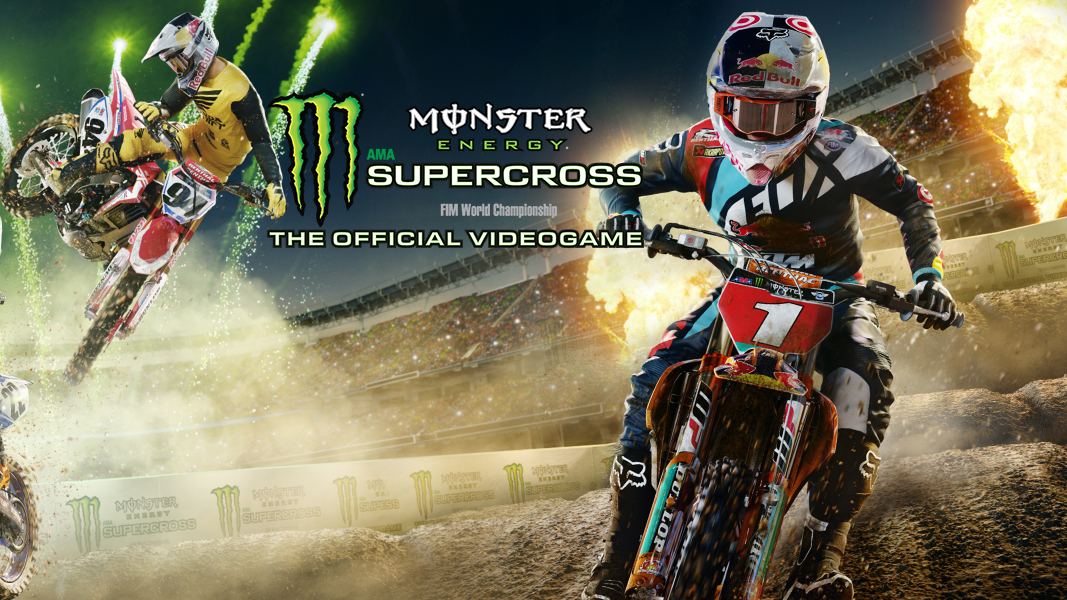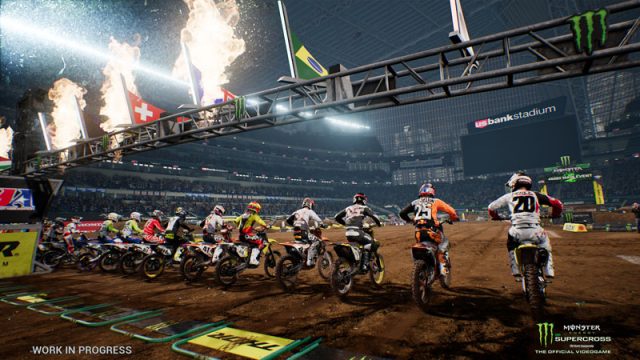
Stadiums play host to all sorts of different events, not just concerts and traditional sporting affairs. This includes machines of the car, truck and dirt bike varieties, including those used in the AMA Supercross Championship. It’s this league, and its two wheeled chariots, that act as the focus of our game of the day: Monster Energy Supercross: The Official Videogame.
Developed by Milestone, who recently released Gravel onto our consoles and PCs, Monster Energy Supercross: The Official Videogame is a more regimented and focused title. It does its best to provide fans with a way to experience and interact with their own version of the AMA Championship, via coloured and perhaps even personalized controllers. The result is a decent but flawed outing that fails to really rise above what’s come before it. That’s not to say we’re talking about a bad game here, because we’re not. Just an unfortunately mediocre one.
The crux of this racer is designed around the league, itself, and the close to twenty different events that make up its yearly regiment. Big, stadium-based outings that take place in both indoor and outdoor arenas like Angel Stadium and Toronto’s Rogers Centre. They’re all surprisingly similar, too, despite offering different track layouts, though open aired locations do allow for the potential for rain. Even then, none of them stand out that much. Hell, most even start off with a straightaway followed by a sharp left turn that leads into lots of bumps and jumps. Of course, this repetition cannot be blamed on the game or its developers, since that’s just how the sport is.
There are three different championships: the 250 West, the 250 East and the 450, which is made up of a mixture of both. You’ve probably already guessed this, especially if you’re a fan of the sport, but West delineates events based on the West Coast (like Anaheim, Glendale, Oakland and San Diego), while East contains events set in Eastern cities like Toronto and Arlington. Hell, there’s even one set within the confines of the storied Daytona International Speedway.
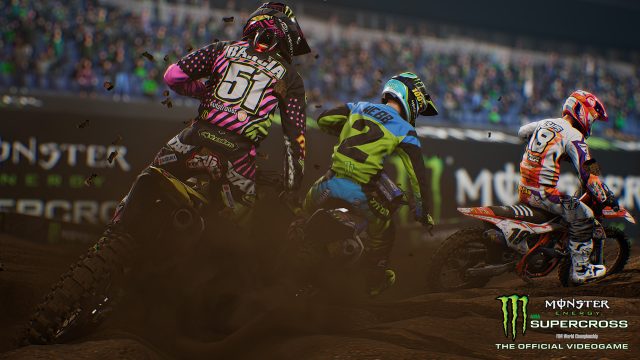
Both of the 250 championships are made up of close to ten different races, while the 450 has seventeen. For whatever reason, a few from the previous tier didn’t make the cut for the more advanced championship, but that’s okay. It’s still decently lengthy, so long as you opt in for the full experience, meaning a few rounds of qualification prior to each main event. If you don’t, and go with the shortest option, you’ll simply play each city’s core race and nothing more. That’s obviously a much, much faster option which abbreviates the game’s length quite dramatically.
What’s good about all of the above is that the developers didn’t force anything upon the player. Purists will want to do all of the qualifying, but others may not feel interested or have the time. I’ve never been a fan of qualifying, so I didn’t really bother with it and appreciated being able to turn it off. The same type of thing carries over to the game’s rewind feature, which is purely optional and is never forced. Some people hate the idea of rewinding a racing game, and that’s fine — they don’t need to use it.
The racing is what you’d expect: traditional arena motocross upon dirt and mud-based tracks. There’s lots of jumps to negotiate, as well as more then 20 opponents to both pass and avoid. It doesn’t reinvent the wheel in any way, but had to stay true to the sport it digitizes. Thankfully, there is some track deformation, as well as a good amount of difficulty and control options to choose from, including a realistic challenge level and ‘normal’ physics that are supposed to be akin to real world racing yet leave something to be desired.
Milestone surely put a good amount of effort into Monster Energy Supercross: The Videogame, but it does feel rushed and a bit low budget in some respects. The overly twitchy physics happen to be one area where this is felt most, because the bikes and their riders will often bounce around the tracks in unrealistic ways. Hell, you’ll sometimes even land on top of another rider and essentially ride on his head for a moment, until you land back on the dirt. The computer will do the same to you, as well.
During a race, it can be difficult to tell what, exactly, will cause a crash and what won’t. It seems like the game doesn’t always know, either, because different results will come from the same type of sharp turn, or hitting a barrier in the same way. Sometimes landing on another racer’s head will cause you to crash, and sometimes it won’t. The good news here, though, is that the rewind feature is available to erase any mistakes that the game’s wonky physics may make. If it wasn’t, this thing would be more frustrating.
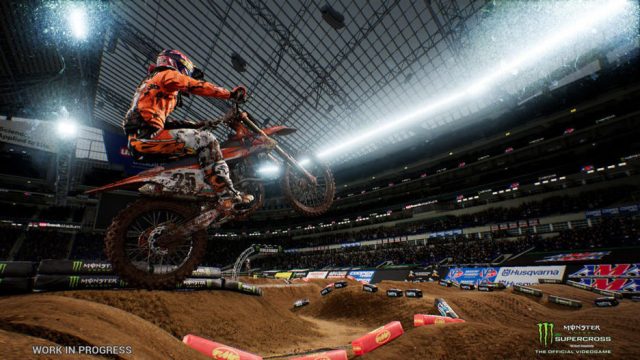
Please don’t get the idea that crashes happen incredibly often, or that the game will constantly glitch out. That’s not the case. It just happens more often than it should, and can occur randomly during a race. I didn’t have to use the rewind feature too, too often, but probably took advantage of it at least two times per each four to five minute-long event. Crashing also isn’t uncommon in the real life sport this game emulates, especially given how many racers come out of the starting gates at almost the exact same time.
Crashes will also, of course, be dependent on your skill level. I played on an easier difficulty, and tried to tinker with the controls to make them more suitable for me, but found it tough to do so. It’s not possible to assign both brakes to the same button, nor is it possible to actually shift one’s weight or prepare for a jump using the left joystick. For whatever reason, the developers decided to make the left trigger the one brake and the A button (I believe) another. Meanwhile, you steer with the left joystick, but must awkwardly utilize the right one if you’d like to tilt before a jump or in mid-air.
It’s awkward
It was at the beginning of many races where I encountered another of the game’s unfortunate flaws, that being frame rate slowdown and slight pauses. The conclusion I drew was that it was having trouble keeping a constant framerate due to all of the individual riders clumped together at the first corner of each race. As per usual, it’s a mad dash from the gate, and you’ll often find yourself clumped in with ten to twenty other racers as you reach and attempt to go around the first bend. At least, I did. It was there that I felt the game struggle, and encountered a couple of slight freezes that lasted a few seconds each. This was disappointing in a game where speed, handling and precision are expected to be important and generally are, apart from when the physics act up.
The career mode allows you to create, then outfit your own personal rider through a meager creation suite. The outfits and accessories, themselves, are licensed through companies like FOX and Oakley, and allow for a bit of colourful personalizing. Bikes can also be purchased and upgraded with better parts (exhaust, brake pads, tires, rims, handlebars, etc.), which increase their statistics. You really only need one bike, though, because there don’t seem to be many differences outside of the manufacturers and their colour schemes. Sponsors that you choose also affect your liveries, so it’s not like you need to worry colour all that much.
All of the above can be purchased through credits that are earned through completing races and landing on their respective podiums. It costs a lot to buy parts, but after a while credits won’t be an issue, so long as you keep coming in first, second or third. However, while this is the only upgrade system found inside of this title (and a basic one at that), credits aren’t the only thing you’ll earn as you progress. In fact, there’s also a prestige system that levels your profile up through experience points earned based on placing and skill moves pulled off within each event. By that, I mean jumps, perfect landings and drifts.
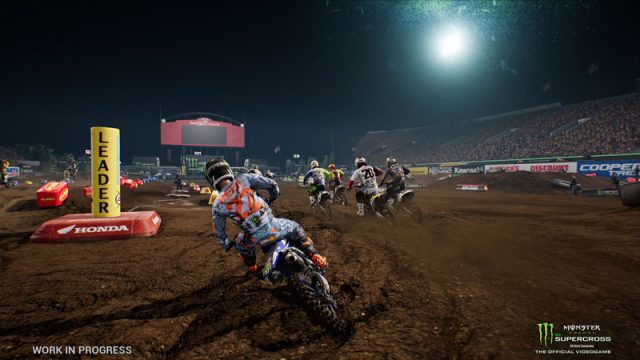
Getting to certain prestige plateaus unlocks achievements as well as new helmets. I didn’t notice much else, but could have missed something. By the end of the last career championship, I was level 70, and the final achievement is for getting to prestige level 100.
Outside of the career mode and its three different, points based championships, Monster Energy Supercross: The Official Videogame offers the types of secondary modes that you’d expect from such a racer. There’s single event play, time trials, and customizable championships. On top of those, you’ll also find a pretty robust track editor and an online set-up that allows for single event or championship play. I tried to test the latter out, but couldn’t find any other players when I searched.
The track editor is a nice feature, because it allows for variety. Through it, you’re free to design the type of track(s) that you want to race on, and can share them with the world. Don’t play the ones I made, though, because they suck.
When it comes to presentation, Milestone’s Monster Energy Supercross is a mixed bag. Its dirt and mud look relatively nice, and its environments can too, but its rider animations leave something to be desired. They’re stiff, wooden and not so real. I’ve also already mentioned the frame rate problems, which appear more often than anyone would like, but aren’t debilitating or terribly game breaking. They affect things momentarily, before the frame rate goes back to normal.
That said, this will never be considered a great looking game. It looks fine, for the most part, but it’s not a showpiece.
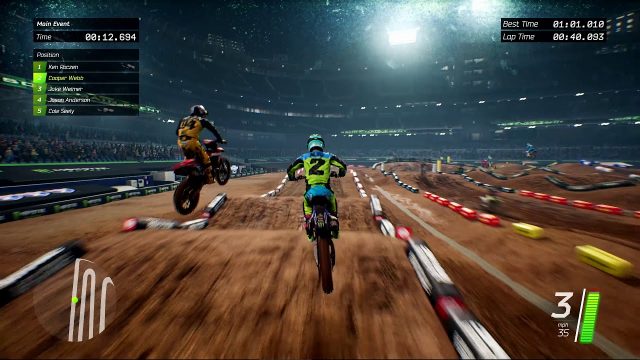
The audio is the part that really feels lacking. While the engine sounds are decent, there’s little else to write home about when it comes to sound. The announcer is middling at best, and thankfully only talks at the beginning and end of each race. The music, on the other hand, comes and goes. It’s very bland and basic, and is made up of the same two or three rock and nu-metal instrumentals that are forgettable and repetitive to say the least. You may want to hit mute, then turn on a playlist of your own music before playing.
This review has been pretty critical, but Monster Energy Supercross: The Official Videogame is not bad. It’s just not anything special, or what it could’ve been had it been given more time in the proverbial oven, and a bigger budget to boot. Through it, Milestone has created a decent and serviceable motocross game, but it’s one that lacks the polish, nuances and physics that it’d need if it were to ever be called great. Things tend to get repetitive too quickly, and it simply doesn’t feel like this game (or its genre) has evolved enough from the days of MX 2002 Featuring Ricky Carmichael, which I spent tens of hours playing on my PS2.
**This review is based on the Xbox One version of the game, which we were provided with. We played it on an Xbox One X review unit.**

